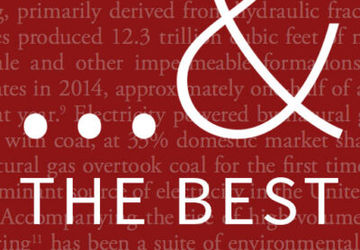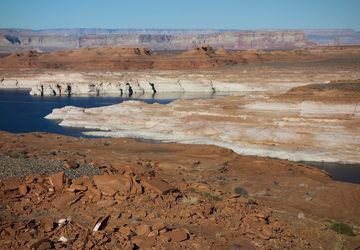The Whittier Fire burns in Goleta, CA, July 2017. Photo by Glenn Beltz via Flickr.
Wildland fires have impacted California in devastating ways over the past several years. While 2019 brought Public Safety Power Shutoffs – planned blackouts to prevent major wildfires from sparking – 2017 and 2018 saw the most destructive and deadly blazes recorded in the state’s history. At the Bill Lane Center for the American West, students and scholars have long been engaged in environmental governance and climate resilience coursework and research, particularly as it pertains to wildfire policy. The environmental reporting we offer in our “…& the West” blog has taken up wildland fires in the West on numerous occasions. In addressing the threats posed by climate-linked disasters, our aim has always been to provide helpful tools, reporting and research to those who make decisions that impact California and the West. So when given the opportunity to participate in a hackathon focused on wildfire-related problems, the Bill Lane Center was eager to pitch project ideas for Stanford student teams to tackle.
Developing “hacks” to address the region’s environmental challenges
The purpose of Stanford’s Big Earth Hackathon in general is to bring students together from multiple disciplines to generate real solutions to some of the Earth’s biggest problems. This year, during spring quarter, hackathon organizers challenged participants to explore the “multi-faceted, highly critical and challenging topic of wildland fires,” in three focus areas: equity and fairness, prediction and analysis, and mitigation. Teams of students were asked to develop projects in any of these areas, or at the intersection of one or more areas. In conjunction with the event, Stanford also offered an optional course co-taught by Big Earth Hackathon Director Derek Fong, providing structure and mentorship for hackathon participants.
According to Fong, who led the first three Big Earth Hackathons and has a background in oceanography and environmental fluid mechanics, the Wildland Fire Challenge course introduced students to some of the important issues related to wildfire, and then created a community of support to help students with their projects. The course also held optional workshops from industry experts exposing students to state-of-the-art tools for data analysis and visualization.
The resulting hackathon student projects are both innovative and inspirational. With our ongoing commitment to contributing solutions to local and regional problems, and a focus on the practical application of knowledge, the Bill Lane Center participated in the event with enthusiasm. Iris Hui, the Lane Center’s senior researcher, pitched a project on local ballot measures in California elections, asking students enrolled in the hackathon course to consider the following questions: What are the factors that predict the success and failure of ballot initiatives related to wildfire? And how long is the policy window for implementing wildfire measures (i.e. the length of time after a major fire occurs wherein a city can successfully pass a measure)?
“Students did a very impressive job and put together a wide array of datasets to answer these questions,” Hui stated, commenting on the project submitted by a hackathon team made up of Lauren Borja, Nathan Dadap and Madeleine Gates. This team's initial results suggest that one of the key factors determining the outcome of a fire-related ballot measure is the amount of time that has passed since the last fire (within 25 miles of a city). Their findings show that measures are more likely to pass after a recent fire. "So a next logical question," wrote Nathan Dadap, in an email explaining his research, "was how long after a fire does the presence of the fire affect the ballot outcome? Basically, how long after a fire are people still thinking about it at the ballot box?" Both policymakers and fire departments might value the answers to these questions, Dadap continued. In spite of California's environmentally progressive reputation, and its history of both drought and wildfire, the team found that only 72.3% of ballot measures associated with fire passed in California between 2003 and 2018. "While the responsibilities for fire-fighting are spread amongst various governing structures within California, these measures directly impact the funding sources that contribute to a city's ability to fight wildfires," Dadap explained.
First gather data, then develop learning models
What kind of data did Dadap, Borja and Gates need to collect in order to answer their project's guiding questions about wildfire and ballot initiatives? Anything related to voting, such as fire history, demographic, political and economic data. The team also aggregated the ballot data.
"Once we had a dataset that matched these various pieces of information across time and space, we created a few machine learning models which allowed us to understand which factors are most important for predicting voting outcomes." The models may prove useful for policymakers who are curious about how appealing future fire-related ballot measures might be to voters. "Voting behavior is no doubt complex and governed by lots of factors. But we found that a few key factors had an outsized effect on our ability to predict which ballots passed and which ones did not," Dadap added, listing the following factors:
- Number of fires in the last five years. Areas with passing ballots had 20% more fires in the last five years than areas with failed ballots.
- Time since last fire. Areas with passing ballots had experienced a fire nearly two weeks more recently than areas with failed ballots. Furthermore, the rate of ballots that pass appears to drop by about 30% after three years since the last fire.
- Political ideology. Areas with passing ballots had a higher percentage of registered Democrats than areas with failed ballots.
- Fraction of revenue spent on fire-fighting. If the ballot was a lower fraction of the total city revenue, it was more likely to pass.
Student projects recieved glowing reviews from experts in the field
In an email to Derek Fong assessing the effectiveness of the event, David Shew, former Cal Fire Division Chief and a wildfire hackathon judge, wrote the following: “Overall, I see advances in vision and technology across the board. From early detection, defensible space, evacuations, damage assessment, community recovery, carbon output, and ballot measures, each team picked a topic that is desperately in need of improvements – and each of them present logical steps to push the boundaries of the status quo. It is quite clear that their research was thorough, and they listened to the problems. Their solutions were not restricted by the common attitudes found in the fire service. The innovation is astounding, and I am quite impressed with all of them – they all deserve kudos.”
The Bill Lane Center congratulates the Big Earth Hackathon Wildfire Challenge organizers and participants on their great success. We are proud to collaborate with students and researchers across disciplines to face grave environmental challenges with both imagination and optimism.



